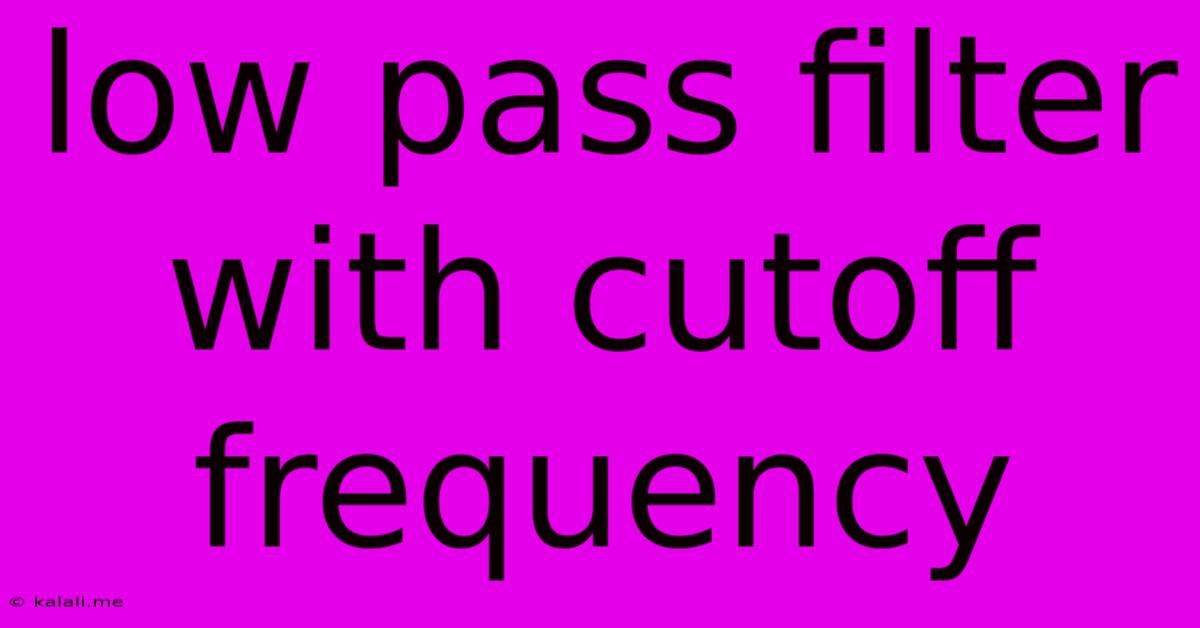Low Pass Filter With Cutoff Frequency
Kalali
May 21, 2025 · 3 min read

Table of Contents
Understanding Low Pass Filters and Cutoff Frequency
A low-pass filter is a type of electronic filter that allows signals with frequencies below a certain cutoff frequency to pass through while attenuating signals with frequencies above the cutoff frequency. This makes them essential components in many electronic circuits, from audio systems to digital signal processing. Understanding how they work, particularly the concept of cutoff frequency, is key to their effective application. This article will delve into the intricacies of low-pass filters and their crucial cutoff frequency parameter.
What is a Cutoff Frequency?
The cutoff frequency (f<sub>c</sub>), also known as the corner frequency, is the frequency at which the output power of the filter is reduced to half its maximum value. This corresponds to a 3dB reduction in the signal's power, or approximately a 70.7% reduction in amplitude. It's the point where the filter transitions from passing signals to attenuating them. The sharpness of this transition is determined by the filter's order and design. A higher-order filter will have a steeper roll-off, meaning a more abrupt attenuation of frequencies above the cutoff.
Types of Low Pass Filters
Several types of low-pass filters exist, each with its own characteristics and applications:
- RC Low-Pass Filter: This is the simplest type, consisting of a resistor (R) and a capacitor (C) in series. It's characterized by a gradual roll-off of frequencies above the cutoff.
- LC Low-Pass Filter: Utilizing inductors (L) and capacitors (C), LC filters offer sharper roll-offs compared to RC filters and are suitable for higher-frequency applications.
- Active Low-Pass Filters: These filters incorporate operational amplifiers (op-amps) to provide gain and improve performance characteristics such as impedance matching and sharper roll-off. Common configurations include Sallen-Key and multiple feedback topologies.
- Butterworth, Chebyshev, and Bessel Filters: These are different filter designs that optimize for different characteristics such as flat passband response, sharp cutoff, or linear phase response. Each design offers a trade-off between these characteristics.
Calculating Cutoff Frequency
The cutoff frequency for different filter types is calculated differently.
-
RC Low-Pass Filter: The cutoff frequency (f<sub>c</sub>) is calculated using the formula: f<sub>c</sub> = 1 / (2πRC), where R is the resistance in ohms and C is the capacitance in farads.
-
LC Low-Pass Filter: The calculation is more complex and depends on the specific circuit configuration (series or parallel LC). However, the basic principle remains similar, involving the inductance (L) and capacitance (C) values.
Applications of Low Pass Filters
Low-pass filters are ubiquitous in various applications, including:
- Audio Systems: Removing high-frequency noise and hiss from audio signals.
- Image Processing: Smoothing images by reducing high-frequency components (noise).
- Telecommunications: Filtering unwanted signals in communication channels.
- Power Supplies: Suppressing high-frequency ripple in DC power supplies.
- Signal Conditioning: Preprocessing signals to remove unwanted high-frequency components before further processing.
Choosing the Right Low-Pass Filter
Selecting the appropriate low-pass filter depends on several factors:
- Cutoff Frequency: Determine the desired frequency at which attenuation begins.
- Roll-off Rate: How sharply the filter should attenuate frequencies above the cutoff.
- Impedance Matching: Ensure the filter's input and output impedance match the connected circuits.
- Cost and Complexity: Balancing performance with cost and design complexity.
Understanding low-pass filters and their cutoff frequency is crucial for any engineer or hobbyist working with electronic circuits and signal processing. By carefully selecting the right filter type and designing it to meet the specific requirements of an application, you can effectively manage signal frequencies and improve the overall performance of your system. This includes understanding filter order and the impact of various filter designs on the transition band.
Latest Posts
Latest Posts
-
Toilet Not Flushing Properly Water Rises
May 21, 2025
-
Walk From Euston To St Pancras
May 21, 2025
-
How Many Planets Are In No Mans Sky
May 21, 2025
-
What Are You Up To Now
May 21, 2025
-
How Long Does It Take Tile Grout To Dry
May 21, 2025
Related Post
Thank you for visiting our website which covers about Low Pass Filter With Cutoff Frequency . We hope the information provided has been useful to you. Feel free to contact us if you have any questions or need further assistance. See you next time and don't miss to bookmark.